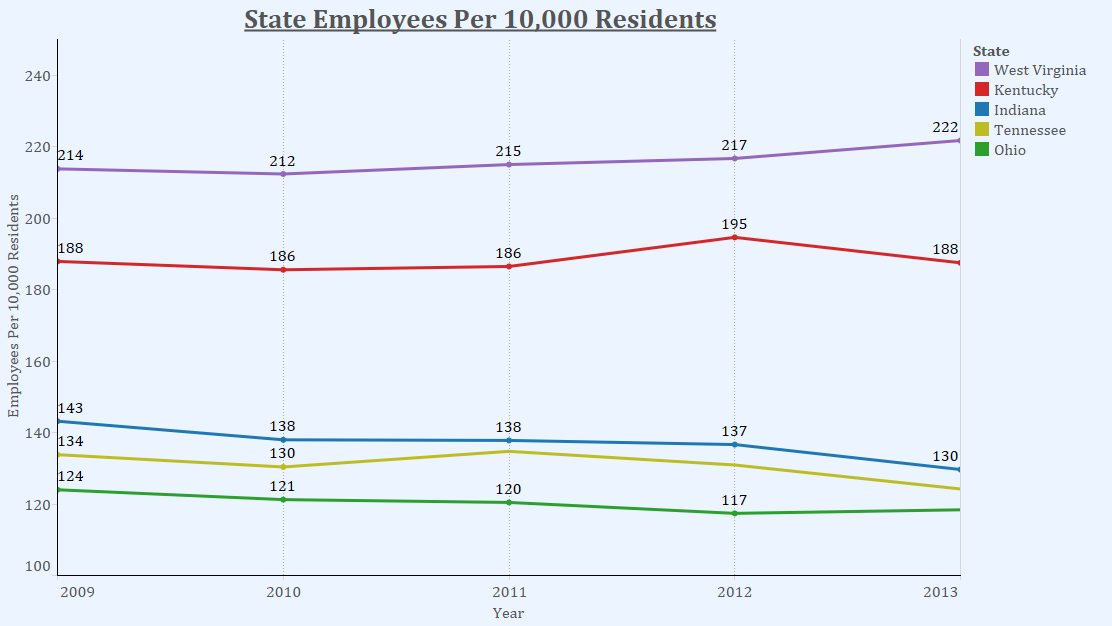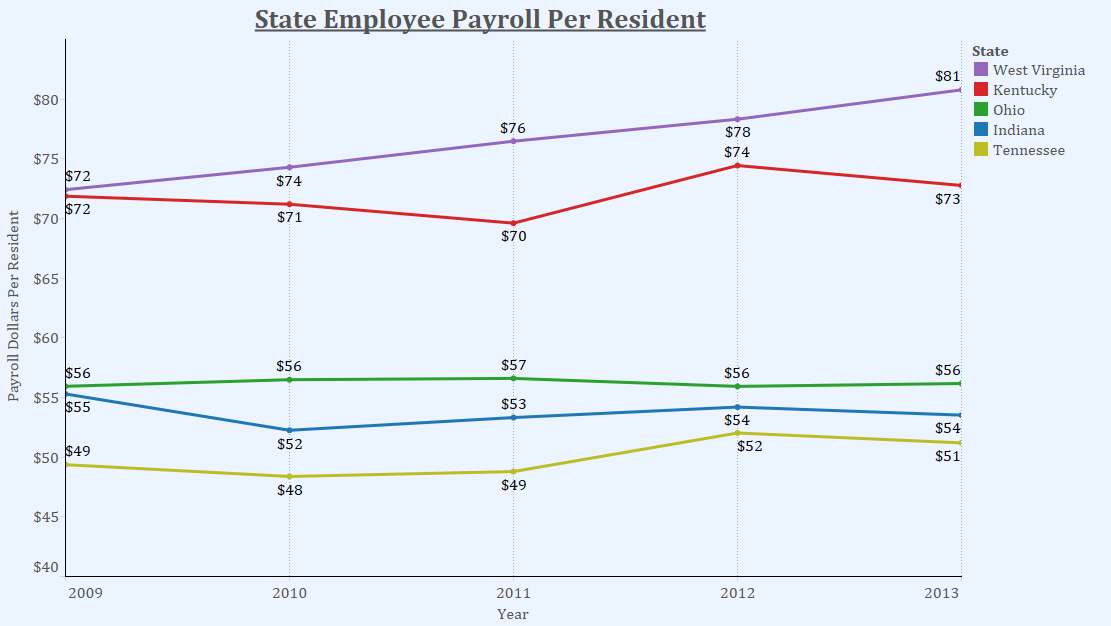Connecting state and local government leaders
Here’s how the Bluegrass State compares to its peers in terms of staff and payroll.
Downsizing Kentucky’s state government was among the priorities Matt Bevin staked out during his gubernatorial campaign.
The Republican businessman handily beat his Democratic opponent, Kentucky Attorney General Jack Conway, in last week’s election. His win marked only the second time since the 1960s that Kentucky voters have elected a Republican as governor.
Bevin’s pledge to nix Kentucky’s Kynect health insurance exchange has grabbed attention. But the first section on the issues page of his campaign website highlighted another goal: “Shrink the Size of Government.” It contends that Kentucky needs to reduce the size of government at the state level “through efforts that remove redundancy and waste in every department.”
So just how big is the government in the Bluegrass State?
Data from the U.S. Census Bureau offers some indication.
An annual survey of state and local governments the Census Bureau publishes includes figures for the number of “full-time equivalent” employees working for each state government in the U.S. Full-time equivalent employees is a measure that includes both full-time and part-time posts. It’s calculated by adding up part-time jobs to equal an equivalent number of full-time positions.
The survey also provides information about monthly payroll costs.
Throughout any given year, the number of employees fluctuates for state governments month-to-month. The Census survey results are not annual averages. They provide only a snapshot of a March pay period for each state. The most recent available data is for 2013.
So what do the numbers show about Kentucky?
More Employees Per Resident Than Most Neighbors
Compared to four neighboring states—Indiana, Ohio, Tennessee and West Virginia—Kentucky had the second-highest number of state employees per 10,000 people in every year between 2009 and 2013.
In 2013, this figure was 188.
The only state among the group that consistently had more employees per 10,000 residents was West Virginia, where the number was 222 in 2013. For the other three states the figure was between 118 and 130 during that year.
According to the Census Bureau figures, the total number of full-time equivalent employees in Kentucky was 82,494 in 2013. The state’s population at that time was around 4.4 million.

Trending Upward
The U.S. Bureau of Labor Statistics also tracks state government employment. Their figures for the number of state employees in Kentucky are slightly higher than the Census Bureau’s. In March 2013, the BLS numbers have about 18,100 more people on the state’s payroll compared to the numbers in the Census survey.
That difference aside, the Bureau of Labor Statistics figures show that the overall number of state employees in Kentucky has been trending steadily upward, particularly since 2009.
In August 2015, the number of people on the state’s payroll measured about 107,500, according to the Bureau of Labor Statistics data. That’s the highest it has been at any time dating back to 1990, and higher than the total number of employees on the payroll in three other states with populations ranging roughly from 3.9 million to 5 million people—Louisiana, Oregon and South Carolina.
This chart shows the total number of people on state government payrolls, employed full- or part-time, who received pay (whether they worked or not) for any part of the pay period that includes the 12th day of the month. Temporary and intermittent employees are included, as are any employees who are on paid sick leave, on paid holiday, or who work during only part of the specified pay period. The figures are seasonally adjusted. The data are from the Bureau of Labor Statistics, and were retrieved via the Federal Reserve Bank of St. Louis.
Kentucky’s population has grown in recent decades. In 1990 it was around 3,686,892, according to the Census Bureau. In 2014, it was estimated at 4,413,457. That’s about a 19 percent increase. Between January 1990 and January 2014, based on the figures published by the Bureau of Labor Statistics, the number of state employees grew by about 41 percent.
Payroll Costs Per Resident Tend to Be Higher, Too
How does Kentucky stack up to its neighbors when it comes to payroll costs?
Here again the state was a leader after taking population into account, though West Virginia, once again, came out on top.
During March 2013, state payroll costs worked out to about $73 per resident in Kentucky. For West Virginia they checked in at $81. In contrast, the per-resident payroll costs in surrounding states were between $51 and $56.

The total monthly payroll figure for Kentucky in March 2013 was around $320 million, the Census data show. For West Virginia it was far lower at that time—$149 million—but the state also had far fewer people, with a population of about 1.8 million.
Education is Big Part of Payroll, But Has Seen Recent Cuts
About half of Kentucky’s payroll costs during March 2013, roughly $162 million, paid for positions related to higher education, including teaching posts, based on the Census data. Higher education is also the category that 38,830, or about 47 percent, of the full-time equivalent employees fell into.
But higher education spending in Kentucky has seen slashing in recent years, according to a report issued in May by the Center on Budget and Policy Priorities, a nonpartisan Washington think tank. The state, the report notes, was one of three in all of the U.S. to have cut per-student higher education funding for the last two consecutive years.
Between the 2014 and 2015 fiscal years, the report says that Kentucky axed $179 of higher education spending per student—more than any other state.
In percentage terms, higher education funding there in 2015, per-student, remained about 27 percent lower than where it was in 2008, just after the onset of the Great Recession. That’s after adjusting for inflation. Meanwhile, the average tuition price has gone up at four-year public colleges and public universities in Kentucky by about 28 percent since that time.
During a debate in July, Bevin and Conway both declined to pledge that they would restore state university budgets to 2007 levels. Bevin, according to the local community news publication, Insider Louisville, said he was “not going to promise money we don’t have.”
Bill Lucia is a Reporter for Government Executive’s Route Fifty.

NEXT STORY: Can Baltimore County Compete With Silicon Valley at Cybersecurity?




